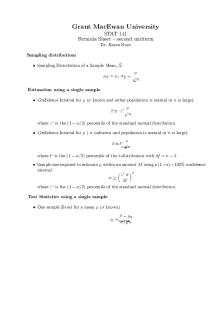Joint shapes - Lecture notes 2 PDF

| Title | Joint shapes - Lecture notes 2 |
|---|---|
| Author | Richard Wilson |
| Course | Anatomy and Physiology |
| Institution | American River College |
| Pages | 2 |
| File Size | 33.6 KB |
| File Type | |
| Total Downloads | 11 |
| Total Views | 126 |
Summary
First semester, Anatomy...
Description
Joint shapes - Uniaxial joints: Hinge joints (elbow joint) - Biaxial joints: saddle joints (metacarpophalangeal joint of the thumb) - Tri axial joints: ball and socket joints (shoulder joint) Structure of tissues: Muscle and nerve tissue Skeletal muscles (striated) - Muscles of the musculoskeletal system, face, tongue, larynx, pharynx and upper esophagus, the Eyeball, middle ear, pelvic floor, and diaphragm. - Are supplied by the somatic nervous system, largely moved voluntarily. Fine structure of skeletal muscles - Primary bundle sheathed by perimysium intern, internally contains endomysium; secondary bundle surrounded by the perimysium extern surrounded by perimysium; total muscle enveloped by epimysium, which is connected to the muscle fascia. Myofibrils Myofibrils = muscle fibrils = longitudinal, contractile element of the muscle cell, which is composed of actin and myosin II with their associated proteins. Ultrastructure of myofibrils - Each myofibril is composed of many parallel thick and thin filaments. - I-band: thin filaments (actin). - A-band: thick filaments (myosin) Sarcomere large, feather-like coiled protein, anchored in M- and Z-disc, responsible for elastic extensibility of muscles. Filament proteins: myosin filament. Myosin filament consisting of interconnected Tail parts of approximately 300-350 myosin II molecules. Heads protrude laterally from the filament.
Motor terminal Contact site of an axon terminal with a muscle fiber. (schematic representation). The axon terminal descends into the muscle fiber. The membrane of the postsynaptic side is strongly folded tubular system - In the sarcoplasm (cytoplasm) of the muscle cell run 2 separate units of fine channels: transversal and longitudinal system § Transverse system: invagination of the outer membrane into the interior of the muscle fiber o Surrounding I and A bands § Longitudinal system: spins around myofibrils and runs perpendicular to the T- system o Calcium ion storage...
Similar Free PDFs

Joint shapes - Lecture notes 2
- 2 Pages

Shoulder Joint - Lecture notes 4
- 2 Pages

Notes Lewis Shapes Polarity IMF
- 8 Pages

Lecture notes, lecture 2
- 3 Pages

2 - Lecture notes 2
- 5 Pages

Lecture notes, lecture Chapter 2
- 11 Pages

Lecture notes, lecture formula 2
- 1 Pages
Popular Institutions
- Tinajero National High School - Annex
- Politeknik Caltex Riau
- Yokohama City University
- SGT University
- University of Al-Qadisiyah
- Divine Word College of Vigan
- Techniek College Rotterdam
- Universidade de Santiago
- Universiti Teknologi MARA Cawangan Johor Kampus Pasir Gudang
- Poltekkes Kemenkes Yogyakarta
- Baguio City National High School
- Colegio san marcos
- preparatoria uno
- Centro de Bachillerato Tecnológico Industrial y de Servicios No. 107
- Dalian Maritime University
- Quang Trung Secondary School
- Colegio Tecnológico en Informática
- Corporación Regional de Educación Superior
- Grupo CEDVA
- Dar Al Uloom University
- Centro de Estudios Preuniversitarios de la Universidad Nacional de Ingeniería
- 上智大学
- Aakash International School, Nuna Majara
- San Felipe Neri Catholic School
- Kang Chiao International School - New Taipei City
- Misamis Occidental National High School
- Institución Educativa Escuela Normal Juan Ladrilleros
- Kolehiyo ng Pantukan
- Batanes State College
- Instituto Continental
- Sekolah Menengah Kejuruan Kesehatan Kaltara (Tarakan)
- Colegio de La Inmaculada Concepcion - Cebu








